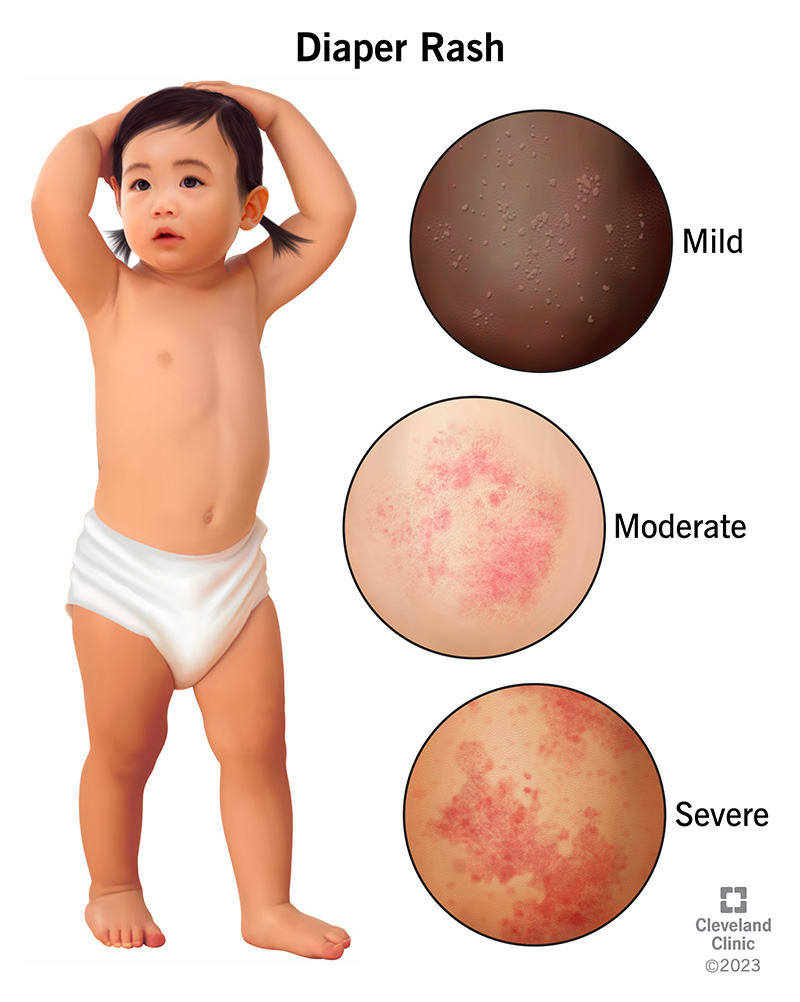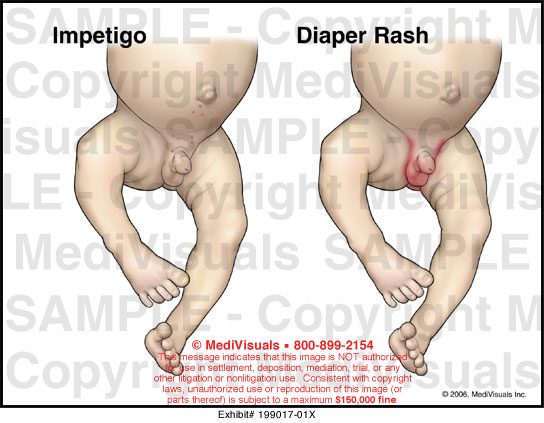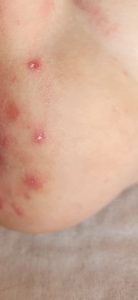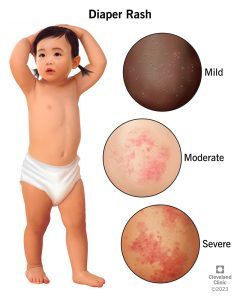Impetigo diaper rash is a contagious bacterial skin infection that causes red sores and blisters. It can be treated with antibiotics and good hygiene practices.
With proper care, impetigo diaper rash can be effectively managed to prevent spreading and discomfort for the child. Impetigo diaper rash, a common bacterial skin infection, often occurs in infants and children. It presents as red sores, blisters, and fluid-filled lesions around the diaper area.
The infection can spread rapidly if not treated promptly. Good hygiene practices and antibiotic treatment are essential for effectively managing impetigo diaper rash. This article will provide insights into the causes, symptoms, diagnosis, treatment, and prevention of diaper rash, offering parents and caregivers valuable information to safeguard their child’s wellbeing.

What Is Impetigo Diaper Rash?
Impetigo diaper rash is a common skin infection that often affects babies and toddlers. It is a highly contagious condition caused by bacteria, which can easily spread through close contact or sharing items such as towels and clothing.
Causes Of Rash
The leading cause of diaper rash is the bacterium Staphylococcus aureus. It can also be caused by Streptococcus pyogenes. These bacteria can enter the skin through cuts, scratches, or insect bites, leading to infection.
Symptoms Of Impetigo Diaper Rash
Common symptoms of diaper rash include red sores or blisters that quickly rupture and ooze fluid, forming a honey-colored crust. The affected area may also be itchy and potentially painful. These symptoms are often localized around the diaper area.
Treating Impetigo Diaper Rash
Treating diaper rash is crucial to ensuring a quick recovery for your little one. If you suspect your child has this condition, it’s important to consult a pediatrician for proper diagnosis and treatment.
Consulting A Pediatrician
A pediatrician will assess the severity of the impetigo diaper rash and provide guidance on the most effective course of action.
Prescribed Medications
- Antibiotics are often prescribed to combat the bacterial infection causing impetigo rash.
- Following the doctor’s instructions is vital for successful treatment.
Topical Treatments
- Applying medicated creams or ointments directly to the affected area helps expedite healing.
- Topical treatments can help alleviate discomfort and reduce the spread of infection.
Home Remedies
- Keep the diaper area clean and dry to prevent worsening of the rash.
- Gently washing the affected area with mild soap can help promote healing.
Preventing Impetigo Diaper Rash
Preventing diaper rash is crucial for the comfort and well-being of your little one. By practicing good hygiene and following a few simple steps, you can significantly reduce the risk of diaper rash. Let’s explore some essential strategies for preventing this uncomfortable condition.
Maintaining Good Hygiene Practices
Regular handwashing and thorough cleaning of the diaper area are essential for preventing diaper rash. Ensure that both your hands and your baby’s hands are clean before and after diaper changes to reduce the spread of bacteria.
Frequent Diaper Changes
Frequent diaper changes are key to preventing impetigo diaper rash. Change the diaper as soon as it becomes soiled or wet to minimize moisture and reduce the risk of bacterial growth.
Using Diaper Rash Creams
Gently applying a diaper rash cream can provide a protective barrier and soothe the skin, reducing the likelihood of impetigo diaper rash. Opt for a mild, fragrance-free cream to avoid irritation.
Opting For Breathable Diapers
Choose breathable diapers made of natural materials to prevent the accumulation of moisture and promote air circulation. This helps in reducing the risk of impetigo diaper rash and maintains the overall health of your baby’s skin.

When To Seek Medical Attention
To address Diaper Rash, promptly seek medical care for proper diagnosis and treatment. Consult a healthcare provider if symptoms persist or worsen for the child’s well-being. Early medical attention is essential to manage and alleviate the discomfort associated with the condition.
In the case of Diaper Rash, it’s crucial to know when to seek medical attention. Identifying persistent or worsening symptoms, as well as high fever or severe pain, can indicate the need to consult a healthcare professional. Here’s what you should know:
Persistent Or Worsening Symptoms
Impetigo Diaper Rash may initially appear as small blisters or red sores on your baby’s buttocks, thighs, or genital area. In most cases, these symptoms subside with proper hygiene and over-the-counter creams. However, if you notice that the symptoms persist or worsen despite your efforts, it’s time to take a proactive step. Seeking medical attention is essential to ensure your little one receives the appropriate treatment for their condition. A doctor can examine the rash and determine if additional intervention is necessary. Remember, early detection and treatment can help prevent any complications that may arise from Impetigo Diaper Rash.
High Fever Or Severe Pain
While a mild fever can be common with various illnesses, a high fever in combination with Diaper Rash should not be ignored. If your baby’s temperature rises above 100.4°F (38°C) or they experience severe pain, seeking medical attention promptly becomes crucial. In some cases, a high fever may indicate a more severe infection or complications from the Impetigo Diaper Rash. A healthcare professional can assess the situation, prescribe appropriate medication, and offer the necessary advice to alleviate your baby’s discomfort. Remember that as a parent, your intuition plays a valuable role in judging your baby’s well-being. If you feel something isn’t right or the symptoms worry you, don’t hesitate to contact a healthcare provider. It’s always better to be cautious and seek medical attention when in doubt.
Complications Of Impetigo Diaper Rash
Impetigo diaper rash can lead to complications like spreading skin infections and scarring if not treated promptly. It is important to consult a healthcare professional for proper diagnosis and treatment to prevent further issues. Proper hygiene and care are essential in managing diaper rash effectively.
Cellulitis
Complications of Diaper Rash can include the development of cellulitis. Cellulitis is a bacterial skin infection that occurs when bacteria enter the skin through a break or crack, such as those caused by impetigo. This infection can cause redness, swelling, and pain in the affected area. Without proper treatment, cellulitis can spread and lead to more serious health problems, making it important to address diaper rash promptly.
Scarring
Another potential complication of diaper rash is scarring. The blisters and sores caused by impetigo can leave behind scars, especially if the sores are scratched or picked. These scars can be permanent, affecting the appearance of the skin. By taking steps to prevent impetigo and promptly treating diaper rash, you can minimize the risk of scarring and ensure your child’s skin heals properly.
Post-streptococcal Glomerulonephritis
In rare cases, impetigo diaper rash can lead to a condition called post-streptococcal glomerulonephritis. This is a type of kidney inflammation that occurs as a result of an immune response to the streptococcus bacteria responsible for impetigo. Symptoms can include swelling, fatigue, and changes in urine output. It is important to seek medical attention if you notice any signs of this complication, as prompt treatment can help prevent long-term kidney damage. To summarize, complications of diaper rash can include cellulitis, scarring, and in rare cases, post-streptococcal glomerulonephritis. It is crucial to address diaper rash promptly and seek proper medical care to minimize the risk of these complications.

Can Diaper Rash Turn Into Impetigo?
Diaper rash can develop into impetigo, a highly contagious skin infection caused by bacteria. It’s essential to seek medical attention if you suspect impetigo to prevent further spread. Keep the affected area clean and consult a healthcare professional for proper diagnosis and treatment.
How Do You Treat Impetigo Nappy Rash?
Treat impetigo nappy rash with good hygiene. Keep the area clean and dry. Gently wash with soap and water. Apply antibiotic ointment to infected areas. Use clean diapers and change frequently. Consult a doctor for further advice or prescribed medication.
What Does Impetigo Look Like On Babies?
Impetigo on babies appears as red sores that can ooze and form yellowish crusts. It usually starts around the mouth and nose and can spread to other parts of the body.
What Rash Can Be Mistaken For Impetigo?
Eczema, ringworm, and contact dermatitis can be mistaken for impetigo due to similar skin symptoms.
Conclusion
Understanding impetigo diaper rash is crucial for parents. Proper hygiene, regular diaper changes, and seeking medical advice are key in preventing and treating this common skin infection. By staying informed and vigilant, caregivers can effectively manage impetigo and ensure the well-being of their little ones.





